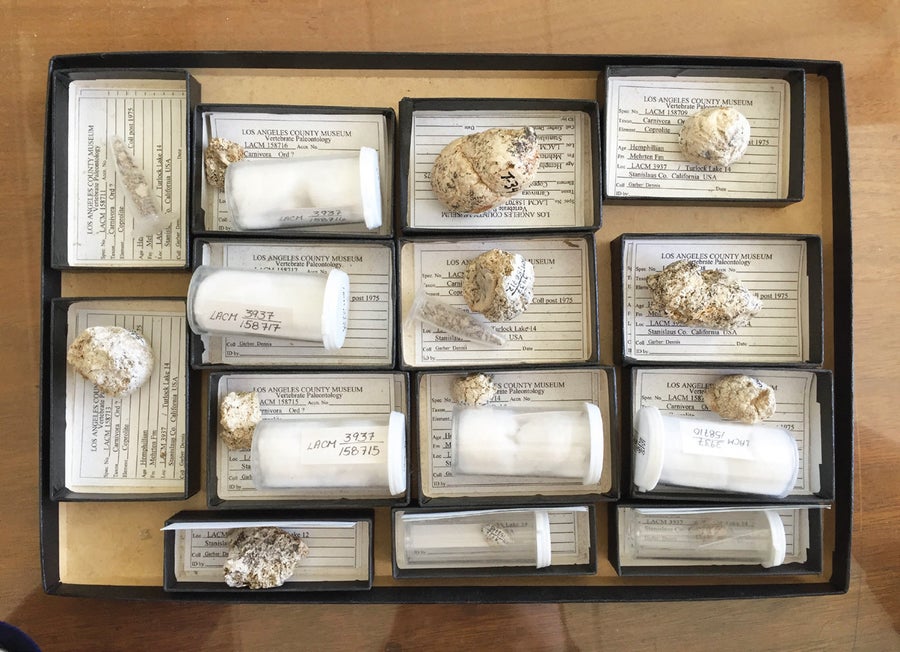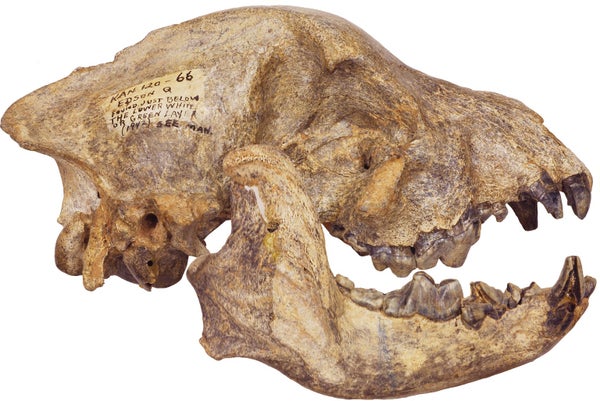An extinct group of brawny carnivores could bite through bone, a cache of six-million-year-old fossilized feces reveals. The bone-crushing dogs, which include the genus Borophagus (“gluttonous eater”), occupied a niche in North America that has not been filled since.
Most carnivores, including today's dogs, sport long, pointy teeth that would likely shatter under the bite force needed to crack open large bones. In contrast, their Borophagus kin had thicker, flattened teeth, as well as shorter snouts that maximized their jaw power. “There is no modern dog that looks like these bone crushers,” says Xiaoming Wang, a paleontologist at the Natural History Museum of Los Angeles County and co-author of a study on the find. “The only analogue that you can try to envision is the spotted hyena in Africa.”

Coprolites, or poop fossils, provide direct evidence of bone-crushing dogs. Credit: Natural History Museum of Los Angeles County
On supporting science journalism
If you're enjoying this article, consider supporting our award-winning journalism by subscribing. By purchasing a subscription you are helping to ensure the future of impactful stories about the discoveries and ideas shaping our world today.
Scientists first noticed the Borophagus' resemblance to hyenas in the late 19th century. Pioneering paleontologist Edward Drinker Cope wrote in an 1893 description of one of the species: “Its dental structure is adapted for crushing bones, while its canine teeth served their usual purpose of tearing.” This was conjecture based only on anatomy, however. The “bone-crushing” nickname stuck, but scientists had no direct evidence that the carnivores could chomp through large femurs and ribs—until now.
Fossil collector and retired soil scientist Dennis Garber says he found the fossilized excrement serendipitously. He was boating on Turlock Lake in California's San Joaquin Valley in 1995 when he spotted a bluish-gray object on the shore. Garber, who has been gathering fossils in that area since 1956, quickly recognized it as a fossilized animal dropping, or coprolite. Because it had bone fragments visible near the surface, it most likely came from a large carnivore—and the Borophagus were the only such creatures known from that area at the time, he says: “I started digging around, and I found quite a few more.”
The study's paleontologist co-authors think what Garber found was a “latrine” area, suggesting that the Borophagus lived in packs and pooped in the same spot, as many modern social carnivores do. The finding, which was published in May in eLife, “gives us an insight, not only into the physiology of these extinct carnivores but also into their social systems,” says paleontologist Julie Meachen of Des Moines University, who was not involved in the study.
To peer inside the coprolites, the study authors enlisted researchers at the University of California, Los Angeles, School of Dentistry to run CT scans. The resulting images revealed skeletal fragments within each lump. These included a large piece of rib from a deer-size herbivore, which the scientists estimate could have weighed up to four times as much as one of its attackers. This adds to the evidence that the Borophagus were pack hunters—but it does not completely rule out scavenging, Wang says. “What surprised me is the number of bones,” he adds. That quantity, combined with the dogs' jaw adaptations, indicates that biting through and swallowing large chunks of bone seem to have constituted part of their routine.
Wang suggests that in addition to being pack hunters, endurance runners and social poopers, the Borophagus may have been competitive eaters. Hyena packs can devour entire wildebeests—bones and all—in a few minutes, and the carcass is first come, first served. When every meal is a race, being able to crunch straight through femurs and tear off a large hunk of leg for oneself is a big advantage. The Borophagus may have had similar dining etiquette. Meachen agrees with this assessment. “All these carnivores [would] have [had] the same constraints in terms of ‘you must gulp your food down, or it will all be gone,’” she says.
The ancient dogs may also have boosted certain nutrient cycles. Modern hyenas break down skeletal matter much faster than microbes do and leave nutrients such as calcium scattered across the savanna in their chalky, white feces. In contrast, Wang says the Borophagus' digestion was apparently less thorough. “Unlike hyenas, they don't have the kind of advanced, highly acidic digestive system to help them really—shall we say—melt down the bones inside the digestive system,” he says. But crushing up and transporting tiny fragments across the grassland may have had a similar nutrient-spreading effect, he notes.
The borophagine lineage died off mysteriously about two million years ago, leaving no descendants. But it was a major group of carnivores, with dozens of species spanning about 30 million years of North American fossil history. “There's really nothing like this group of animals around today, and yet they lived in North America and potentially had a really important role in the ecosystem, especially allowing for increased processing of carcasses or recycling of nutrients,” says paleoecologist Larisa DeSantis of Vanderbilt University, who was not involved in the study. “So this is a bit of a detective mystery in trying to reconstruct the ecology of these animals.”
